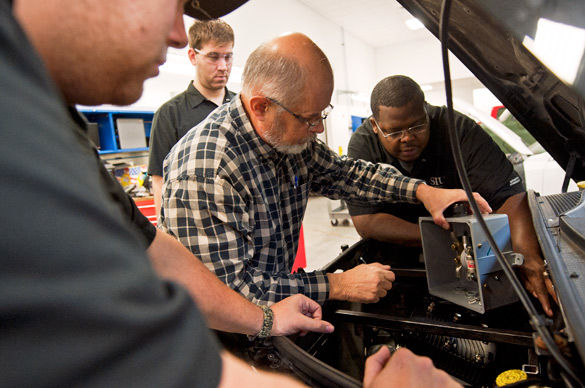Students convert cars to use electricity

November 23, 2014
Students studying automotive technology get chances to work on cars, but it is not every day they are able to create a car of their own.
Andy Ju An Wang, dean of the College of Applied Sciences and Arts, said SIU offers Hybrid and Electric Vehicle Technology, a 400-level course that teaches students about the manufacturing of hybrid and electric vehicles. During the class, which originated in 2006, students convert a gasoline-powered vehicle to a plug-in, electric vehicle.
Wang said half of the class is theory and lecture-based, while the other half is more practical.
Advertisement
“The program is purely tech as of now,” said Wang. “The program offers a very unique learning experience.”
In the automotive technology facility, part of the Transportation Education Center—which Wang said cost $63 million when it was built in 2012—class is conducted unconventionally.
“Tables make up one half of the classroom while the other half is a vehicle,” Wang said.
Ralph Tate, who teaches the course, said the students’ activity in the class pushes it beyond the technical level of education, and it is more hands-on.
Tate said the Green Fund, which is a $10-per-semester student fee, provides the money to buy the hybrid and electric vehicles the automotive program uses for conversion. Alumni and manufacturers also donate hybrid, electric and gasoline-fueled vehicles.
There is an all-time high in the amount of hybrid cars in the U.S., and the sales for electric vehicles are increasing, according to greencarreports.com and hybridcars.com. Although the sales for these types of cars are growing, Tate said there is no specialization in hybrid and electric vehicles in the automotive program.
Other programs in the nation have also produced courses that focus on alternative-fuel sourced cars.
Advertisement*
Ivy Tech Community College in Bloomington, Ind., offers hybrid and electric vehicle certificates that require 24 credit hours of study. The program offers eight individual classes that need to be completed in order to receive certification.
SIU’s automotive technology program has another class, which began in 2013, about hybrid and electric cars, but is theory-based. Alternative Fueled Vehicles, another 400-level course, introduces the environmental concerns of conventional gasoline-powered vehicles to students.
Michael Behrmann, chairman of the automotive technology department, wrote in an email the program has been successful in creating professionals who work with these types of automobiles.
“SIU automotive graduates are employed in various areas within the industry, and some are involved in the development of the next generation of advanced hybrid and electric vehicles,” he wrote.
Terry Lewis, a mechanic at Midas in Carbondale, said he is not sure if one practical course is enough to teach new technicians about alternative fuel vehicles.
Lewis, a 1995 graduate of the automotive technology program, said most of the make-up of conventional gasoline-fueled vehicles and hybrid or electric vehicles are the same. The differences are what source of power the vehicle uses to power the wheels to move.
He said if someone with a hybrid or electric vehicle came to Midas for service, he or she would be referred to the original car dealer because the normal certifications most mechanics receive do not allow them to service alternative fuel vehicles.
Stephan Jilbert, a senior from Madison, Wis., studying automotive technology, said the class is a good start but does not provide the ability to service alternative fuel vehicles.
“If you do not have the specific training, you do not want to mess with the car,” Jilbert said. “Electrical shock is the biggest danger. Most hybrid and electric vehicles in production use voltages of 200-300 volts. Without proper training and tools working with that kind of voltage is dangerous.”
Jilbert expressed disappointment in the course because of the lack of surrogate vehicles.
“One thing that could have been better was the school figuring out a way to get more hybrid and electric cars donated to the program,” Jilbert said.
“The cars that were loaned from the dealership were loaned for about a day. We could not do many experiments because we did not have a lot of time to work with the vehicles. The vehicles were donated to look at their service manuals rather than actually working hands-on with the vehicle,” Jilbert said.
Although the course can be improved, Jilbert said he enjoyed the class and thought it was extensive in discussing the theory behind electric energy in the battery. He said he better understands how that energy is converted to make the tires move.
“Tate had already converted a PT Cruiser into an electric car himself,” he said. “Once he was completely finished with the PT cruiser we took the batteries, motor and motor controller from the PT cruiser and put it into a Mazda Miata. We fabricated the brackets and motor mounts.”
After, the class witnessed the car move using the power the students installed.
“Seeing it come to life was extremely gratifying,” Jilbert said.
Advertisement







